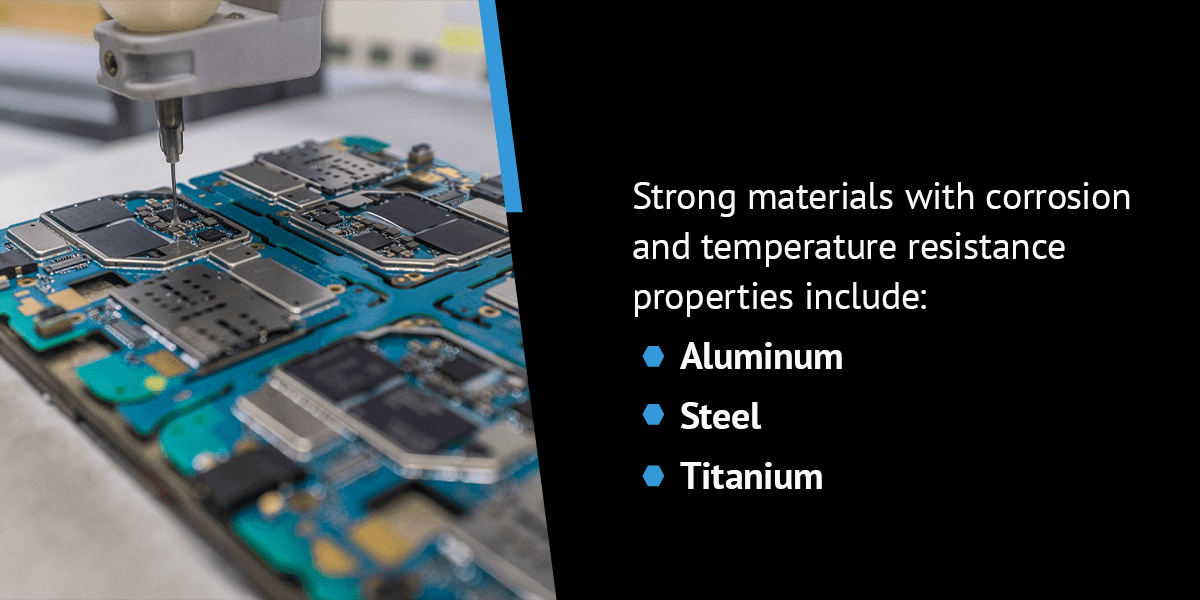
Fasteners are critical components in the assembly and functionality of electronic devices and semiconductors. From mounting heatsinks to securing printed circuit boards (PCBs), the right fastener ensures your devices have electrical connectivity and structural integrity for optimal performance.
In the realm of electronics, where precision, miniaturization and having the right material properties are essential, fasteners consisting of specialty metals for electronics are integral to meeting design and performance requirements.
Choosing the right type of fastener for electronics and semiconductors is key to proper assembly, functionality and stability. The most common fasteners used in these applications include:

At Nickel Systems, we provide a range of fasteners for electronics and semiconductors made with high-nickel-content alloys. These conductive metals for electronic components feature distinct properties that result in greater reliability and performance in various applications:
Whether you need corrosion, gall or heat resistance, you can find fasteners made from a variety of materials and coatings, each with unique properties and benefits. Evaluate the criteria your application demands for these fasteners to determine which material to choose.
Consider the following types of stress that these components should be able to withstand:
Corrosion via oxidation refers to how metals react with oxygen. Fasteners often need a protective coating like zinc or chrome to avoid corrosion. Alternatively, look into nonferrous metals like aluminum, titanium and copper, or use plastic alloys made from different polymers. Using pure nickel, nickel-plated stainless steel, or high-nickel-content alloys like the Hastelloy® and Inconel® formulations described above will also serve this goal while still affording ample strength and reliability in harsh environments.
Each material type has different strength properties. You can compare their room temperature properties in KSI or PSI to determine which material will work best. Some examples of material strengths include:
| Material | Max. Tensile KSI | Max. Yield Strength |
| 2507 Duplex | 116 | 80 |
| Inconel 718 | 126.4 | 60.7 |
| Monel 400 | 180 | 170 |
Find out what temperature range these components should be able to resist. High temperatures can melt any form of plastic or non-ferrous alloy, and some materials can become brittle in extremely cold temperatures.
Specialty metals for electronics have exceptional properties like conductivity, corrosion resistance and a high strength-to-weight ratio. These materials include stainless steel, aluminum and a few alloys that are durable and reliable enough to function in demanding electronic environments.
Understanding the testing and quality control measures for fasteners in this context helps ensure the right material selection. Some procedures manufacturers may use to ensure that components meet stringent standards include:
Choosing the right fasteners requires assessing material types, along with loads, resistance properties, strengths and temperature factors. Additionally, you should think about the following elements:
Ensuring the fasteners you choose for your project are made from the right materials and align with your component’s application is important. The fasteners must be reliable and well-made to deliver the performance you expect. From screws to bolts to rivets, understanding the nuances of fastener types and the materials they come in will help you make a more informed choice.
Nickel Systems offers a variety of fasteners for electronics and semiconductors. From Hastelloy® C276 for Chemical Vapor Disposition to Nitronic® 60 for testing equipment during wafer inspection and more, we have been supplying high-tech fasteners for more than a decade. We can provide you with tight-tolerance vented screws and other specialized fastener solutions. Contact us today for a free quote or give us a call at (610) 632-1964, and we will help you find the right fasteners for your application.
